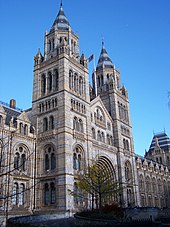1881 in architecture
Appearance
| |||
|---|---|---|---|
| Buildings and structures+... |
The year 1881 in architecture involved some significant architectural events and new buildings.
Buildings and structures
[edit]Buildings
[edit]
- Alþingishúsið in Reykjavík, Iceland, designed by Ferdinand Meldahl, is opened to house the Althing (national parliament)
- British Museum (Natural History) in London, England, designed by Alfred Waterhouse, is opened[1]
- Founder's Building at Royal Holloway College, Egham in England, designed by William Henry Crossland, is completed
- Tweed Courthouse is completed by Leopold Eidlitz in New York City
- The National Theatre (Prague), designed in 1865–68 by Josef Zítek, is opened officially
- Construction of St Stephen's Church, Bournemouth, England, designed by John Loughborough Pearson, is begun
Awards
[edit]- RIBA Royal Gold Medal – George Godwin.
- Grand Prix de Rome, architecture: Henri Deglane.
Births
[edit]- March 29 – Raymond Hood, American Art Deco architect (died 1934)
- August 2 – Walter Godfrey, English architectural historian and architect (died 1961)
- date unknown – Nikolai Ladovsky, Russian avant-garde architect and educator, leader of the rationalist[2] movement in 1920s architecture (died 1941)

Deaths
[edit]- January 25 – Konstantin Thon, official architect of Imperial Russia during the reign of Tsar Nicholas (born 1794)
- April 20 – William Burges, English architect and designer (born 1827)[3]
- December 14 – Decimus Burton, English architect and garden designer (born 1800)
- December 18 – George Edmund Street, English architect (born 1824)
References
[edit]- ^ "Discovering the Natural History Museum". The Telegraph. Retrieved 18 January 2018.
- ^ Not related to rationalism of 18th-19th centuries
- ^ Wroth, Warwick William (1886). . In Stephen, Leslie (ed.). Dictionary of National Biography. Vol. 7. London: Smith, Elder & Co.
